John Ralston Williams, M.D.
John Ralston Williams, M.D.
Biography
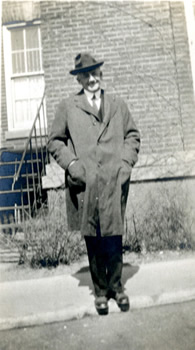 John Ralston Williams was born in Renfrew, Ontario, Canada on December 27, 1874, to John F. Williams and Mary S. (Crozier) Williams. He was raised in Rochester, New York, where he attended the public schools. It is unknown where he did his undergraduate work. Williams received a medical degree from the University of Michigan in 1903, graduating at the top of his class.
John Ralston Williams was born in Renfrew, Ontario, Canada on December 27, 1874, to John F. Williams and Mary S. (Crozier) Williams. He was raised in Rochester, New York, where he attended the public schools. It is unknown where he did his undergraduate work. Williams received a medical degree from the University of Michigan in 1903, graduating at the top of his class.
In 1903-04 he was an assistant in pathology and an assistant in the Hygienic Laboratory at the University of Michigan. In 1905 he returned to Rochester as chief of medical staff at the Infants’ Summer Hospital located on the Lake Ontario shore. In 1906 he was appointed chief of the Division of Medicine at the Hahnemann Hospital in Rochester. He was the first allopathic (or regular) physician to accept a position at a homeopathic hospital in Rochester. Williams held this position for the next thirty years. (In 1921 the Hahnemann Hospital changed its name to the Highland Hospital, reflecting the convergence of homeopathic and allopathic medicine after the First World War.) J.R. Williams is first listed in the annual bulletin of the University of Rochester School of Medicine & Dentistry for 1935-36 as a “consultant” in the Dept. of Medicine. He would retain this association with the School of Medicine through the 1957/58 academic year.
Williams was known nationally for his research on blood analysis and dietary disease. Established in 1916, his laboratory was one of the first in the United States devoted to the study of metabolic disorders –diabetes in particular. Williams was in frequent contact with other researchers in the field, including Elliot P. Joslin, M.D. in Boston and Frederick G. Banting, M.D. in Toronto. When Banting announced his discovery of insulin in 1922, Williams was the first physician in the United States to administer the preparation to a diabetic patient, James D. Havens, the twenty-two year old son of Eastman Kodak vice-president James S. Havens. Because of his extensive understanding of the disorder and its treatment, Williams was made a consultant to Eli Lilly & Co., the firm that first produced insulin commercially, and was selected to test the preparation on diabetic patients. (Williams’ role in the early use of insulin is described in an article by Ralph Madeb, M.D. entitled “The discovery of insulin: the Rochester, New York, connection,” Ann. intern. med., 2005, 143:907-912.)
Williams played an important role in milk production and distribution in Rochester, serving as a member of the American Association of Medical Milk Commissions and the Monroe County Medical Milk Commission. Working with Rochester’s pioneer public health officer George Goler, Williams visited farms that supplied the city with dairy products, monitored sanitary conditions in bottling plants, and conducted analyses of milk samples. Williams was also a pioneer in advocating mechanical refrigeration in American homes, the lack of which was a common cause of bacterial disorders from tainted food.
Williams was also an arborist and was responsible for landscaping the Oak Hill Country Club when it moved from its location on the Genesee River (the present site of the University of Rochester’s main campus) to suburban Pittsford. He served as president of the Rochester Museum Association from 1934 to 1940, and was instrumental in relocating what was then called the Rochester Museum of Arts and Sciences to its present location on East Avenue. Williams retired from the practice of medicine in 1948. J.R. Williams married Ethel M. Rafter in Buffalo, N.Y. on April 7, 1907. The Williams had two daughters and two sons. John Ralston Williams died on December 27, 1965, his ninety-first birthday, at Highland Hospital.
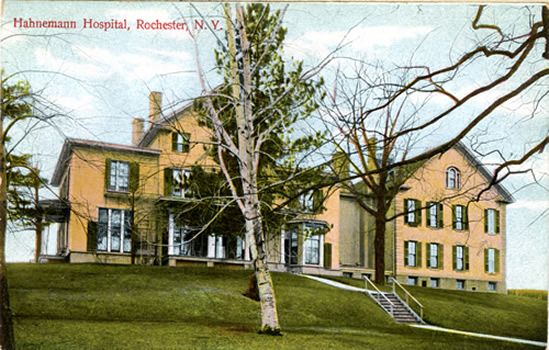
Hahnemann Hospital circa 1906 when J.R. Williams joined the staff
A Description of the Collection
When the archives of Highland Hospital in Rochester, N.Y. were transferred to the Edward G. Miner Library in the summer of 2015, several boxes of material relating to John R. Williams, M.D. were separated from the hospital collection and made a distinct collection. The processing of this collection was completed in December 2015. The Papers of John R. Williams are contained in five boxes and occupy three linear feet.
The collection includes of reprints of articles authored by Williams (Box 1, Folders 3-15); miscellaneous documents generated in the Division of Medicine at Highland Hospital between 1927 and 1938 (Box 1, Folders 16-22); drafts of histories of the Highland Hospital (and its predecessor the Hahnemann Hospital) written by Williams (Box 1, Folder 24 through Box 2, Folder 7); miscellaneous material pertaining to Frederick G. Banting (Box 2, Folders 8-16); and an interesting selection of correspondence (Boxes 2-4).
The correspondence in the J.R. Williams collection may be divided into three categories. The first category is what survives of what must once have been an extensive correspondence file. The material in this portion of the collection includes original letters received and carbon copies of letters written by Williams between 1913 and 1915 (Box 2, Folder 18 through Box 4, Folder 4). This interesting correspondence series, written or received over three consecutive years, includes correspondence with physicians on clinical matters; correspondence with physicians and scientists pertaining to research; correspondence with local and national figures on milk production and distribution; correspondence with patients regarding their illnesses or the payment of outstanding fees; and correspondence on miscellaneous topics relevant to Williams’ work.
The second category of correspondence in the Williams collection is of an incomplete correspondence series dated 1921-1960. The most interesting portion of this series is letters dated 1921-1926 between Williams, Frederick G. Banting, and other individuals in Toronto involved in insulin research. It also includes correspondence with John Murlin at the University of Rochester, whose own research was eclipsed by Banting and Best’s announcement of the discovery of insulin in 1922 (Box 4, Folders 5-9). The remainder of this second category includes Williams’ correspondence with F.B. Beck and others at the Lilly Research Laboratories, correspondence with a variety of individuals regarding Williams’ published appreciation of Banting, etc.
The third category of correspondence among the Williams papers consists of photocopies of letters between Frederick G. Banting, James S. Havens, John R. Williams and others made available to the Highland Hospital (and later to Ralph Madeb, M.D.) by Banting’s biographer, Michael Bliss, Ph.D., of the Dept. of History, University of Toronto (Box 4, Folders 22-28). A portion of this correspondence duplicates letters in Williams’ original correspondence files.
The fifth and final box in this collection contains a small oil painting (20.5 x 26.5 cm.) inscribed on the back of the board on which it is painted: “Banting. 1930. St. Fidele – Que.” This painting must have been given by Banting to J.R. Williams as a token of personal esteem.
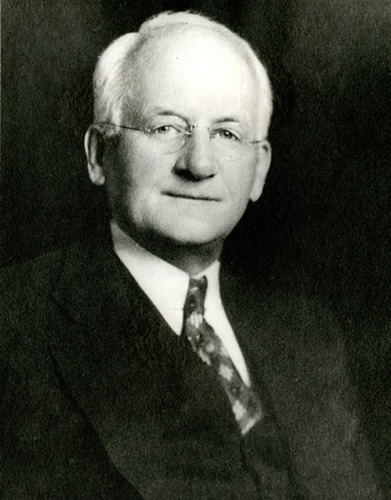
Container List
BOX ONE
- Folder 1: Obituary of John R. Williams
- Folder 2: Clippings and publicity about John R. Williams
- Folder 3: Publications: A study of infant mortality in Rochester (1912)
- Folder 4: Publications: Recent studies in diabetes mellitus (1916)
- Folder 5: Publications: Contributions to pathology and medicine by the Department of Pathology, Hahnemann Hospital, Rochester, N.Y. Volume I. 1916-1919
- Folder 6: Publications: A clinical study of the effects of insulin in severe diabetes (1922)
- Folder 7: Publications: The insulin treatment of diabetes mellitus (1923)
- Folder 8: Publications: Results of the long-continued use of insulin in diabetes (1927)
- Folder 9: Publications: The use of posters as a method of instruction in a diabetic clinic (1928)
- Folder 10: Publications: The social implications of scientific research (1944)
- Folder 11: Publications: The clinical evaluation of insulin (1945)
- Folder 12: Publications: Diabetic manual (1961)
- Folder 13: Publications: A collection of interests, thoughts and experiences (197?)
- Folder 14: Publications: [Two paragraphs on treatment of diabetes] given to Rochester Sunday American to be quoted verbatim (undated)
- Folder 15: Publications: Clinical studies with crystalline insulin, Stearns and Lilly protamine insulinate (undated typescript)
- Folder 16: Highland Hospital. Anemia handbook (192?)
- Folder 17: Highland Hospital. Miscellaneous documents (1927)
- Folder 18: Highland Hospital. Miscellaneous documents (1929-30)
- Folder 19: Highland Hospital. Statement from the staff to the Board of Directors (May 26, 1930)
- Folder 20: Highland Hospital. Miscellaneous documents (1931-32)
- Folder 21: Highland Hospital. Miscellaneous documents (1934-35)
- Folder 22: Highland Hospital. Miscellaneous documents (1936-38)
- Folder 23: Highland Hospital. Library
- Folder 24: Highland Hospital. History of the Hahnemann Hospital by JRW (undated)
- Folder 25: Highland Hospital. Typewritten notes for historical article (undated)
- Folder 26: Highland Hospital. History of the Highland Hospital by JRW (undated “first” draft)
- Folder 27: Highland Hospital. History of the Highland Hospital by JRW (undated five-page version)
BOX TWO
- Folder 1: Highland Hospital. [Highland Hospital history by JRW] (undated six-page version)
- Folder 2: Highland Hospital. History of the Highland Hospital by JRW (undated sixteen-page version)
- Folder 3: Highland Hospital. [Highland Hospital history by JRW] (undated twenty-page version lacking first three pages)
- Folder 4: Highland Hospital. History of the Highland Hospital by JRW (1932)
- Folder 5: Highland Hospital. Historical note (undated)
- Folder 6: Highland Hospital. Secretary’s report, W.H.H. Rogers, 1 Feb 1915, with cover letter of Elizabeth Sibley Stebbins, 5 Mar 5 1934
- Folder 7: Highland Hospital. [Historical timeline] (1968?)
- Folder 8: Banting: James Havens’ charts (May 1922)
- Folder 9: Banting: Banting & Best reprints (1922)
- Folder 10: Banting: Banting’s Nobel Prize lecture (1925)
- Folder 11: Banting: Notes about Banting supplied by Dr. J.W. McDonald, St. Catherine, Ont., at Rochester Dec 9/42
- Folder 12: Banting: Articles on Banting by JRW
- Folder 13: Banting: Christmas cards received from Banting prior to 1941
- Folder 14: Banting: Programs of the International Diabetes Clinic, Indianapolis, 23 Sep 1946, and the celebration of the 25th anniversary of the discovery of insulin, Indianapolis, 23 Sep 1946
- Folder 15: Banting: Card prepared by JRW commemorating the 25th anniversary of the discovery of insulin (Dec 1946)
- Folder 16: Banting: Invitation to a lecture on the discovery of insulin by Prof. Michael Bliss, University of Toronto, at the Rochester Academy of Medicine, 14 Nov 1986
- Folder 17: Miscellanea
- Folder 18: Correspondence (1901, 1902, undated 1913, undated)
- Folder 19: Correspondence (Oct 1913)
- Folder 20: Correspondence (Nov 1-5, 1913)
- Folder 21: Correspondence (Nov 6-15, 1913)
- Folder 22: Correspondence (Nov 16-21, 1913)
- Folder 23: Correspondence (Nov 22-28 (1913)
- Folder 24: Correspondence (Dec 1-10, 1913)
- Folder 25: Correspondence (Dec 11-18, 1913)
- Folder 26: Correspondence (Dec 19-31, 1913)
- Folder 27: Correspondence (undated 1914)
- Folder 28: Correspondence (Jan 1-9, 1914)
- Folder 29: Correspondence (Jan 10-19, 1914)
- Folder 30: Correspondence (Jan 20-30, 1914)
- Folder 31: Correspondence (Feb 3-15, 1914)
- Folder 32: Correspondence (Feb 15-28, 1914)
- Folder 33: Correspondence (Mar 3-17, 1914)
- Folder 34: Correspondence (Mar 20-31, 1914)
- Folder 35: Correspondence (Apr 1-18, 1914)
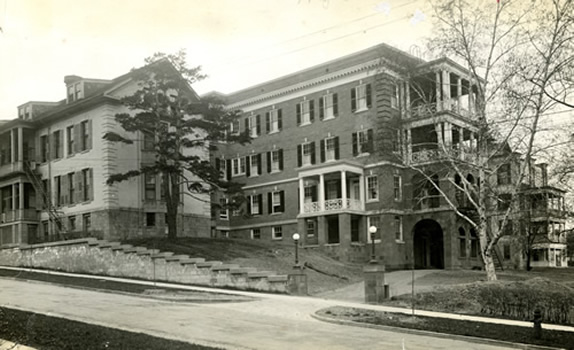
Highland Hospital, emergency entrance, 1924
BOX THREE
- Folder 1: Correspondence (Apr 20-30, 1914)
- Folder 2: Correspondence (May 7-12, 1914)
- Folder 3: Correspondence (May 14-29, 1914)
- Folder 4: Correspondence (Jun 1914)
- Folder 5: Correspondence (Jul 1914)
- Folder 6: Correspondence (Aug 1914)
- Folder 7: Correspondence (Sep 2-19, 1914)
- Folder 8: Correspondence (Sep 21-29, 1914)
- Folder 9: Correspondence (Oct 1914)
- Folder 10: Correspondence (Nov 1914)
- Folder 11: Correspondence (Dec 1914)
- Folder 12: Correspondence (Jan 1915)
- Folder 13: Correspondence (Feb 1915)
- Folder 14: Correspondence (Mar 1915)
- Folder 15: Correspondence (Apr 5-17, 1915)
- Folder 16: Correspondence (Apr 20-28, 1915)
- Folder 17: Correspondence (May 1-19, 1915)
- Folder 18: Correspondence (May 20-30, 1915)
- Folder 19: Correspondence (Jun 1-14, 1915)
- Folder 20: Correspondence (Jun 15-30, 1915)
- Folder 21: Correspondence (Jul 1-19, 1915)
- Folder 22: Correspondence (Jul 21-31, 1915)
- Folder 23: Correspondence (Aug 4-16, 1915)
- Folder 24: Correspondence (Aug 17-30, 1915)
- Folder 25: Correspondence (Sep 2-15, 1915)
- Folder 26: Correspondence (Sep 16-20, 1915)
- Folder 27: Correspondence (Sep 21-30, 1915)
- Folder 28: Correspondence (Oct 1-14, 1915)
- Folder 29: Correspondence (Oct 15-30, 1915)
- Folder 30: Correspondence (Nov 1-9, 1915)
BOX FOUR
- Folder 1: Correspondence (Nov 11-30, 1915)
- Folder 2: Correspondence (Dec 2-9, 1915)
- Folder 3: Correspondence (Dec 10-18, 1915)
- Folder 4: Correspondence (Dec 20-30, 1915)
- Folder 5: Correspondence (1921-1922)
- Folder 6: Correspondence (Mar-May 1923)
- Folder 7: Correspondence (Jun-Dec 1923)
- Folder 8: Correspondence (1924)
- Folder 9: Correspondence (1925-1927)
- Folder 10: Correspondence (1928)
- Folder 11: Correspondence (1930)
- Folder 12: Correspondence (Jan-May 1931)
- Folder 13: Correspondence (Jun-Dec 1931)
- Folder 14: Correspondence (1932-1935)
- Folder 15: Correspondence (Jan-May 1936)
- Folder 16: Correspondence (Jun-Nov 1936)
- Folder 17: Correspondence (1937)
- Folder 18: Correspondence (1938)
- Folder 19: Correspondence (1941-1944)
- Folder 20: Correspondence (1946)
- Folder 21: Correspondence (1947-1960)
- Folder 22: Correspondence. Bliss photocopies (1920-1921)
- Folder 23: Correspondence. Bliss photocopies (Mar-Jun 1922)
- Folder 24: Correspondence. Bliss photocopies (Jul-Aug 1922)
- Folder 25: Correspondence. Bliss photocopies (Sep-Dec 1922)
- Folder 26: Correspondence. Bliss photocopies (1923)
- Folder 27: Correspondence. Bliss photocopies (1924-1944)
- Folder 28: Correspondence with Michael Bliss, Ph.D.
BOX FIVE
- St Fidele, Que. 1930 [oil painting on board by F. Banting, given to JRW]
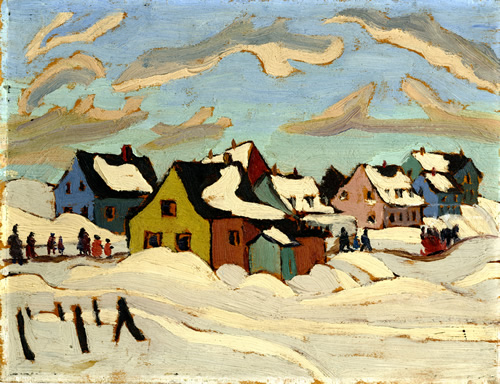
Fredreick G. Banting, M.D. St. Fidele, Quebec, 1930